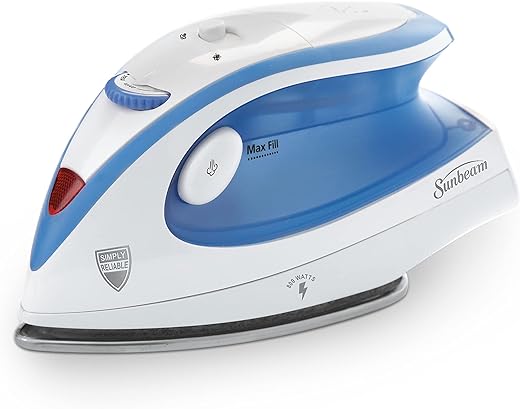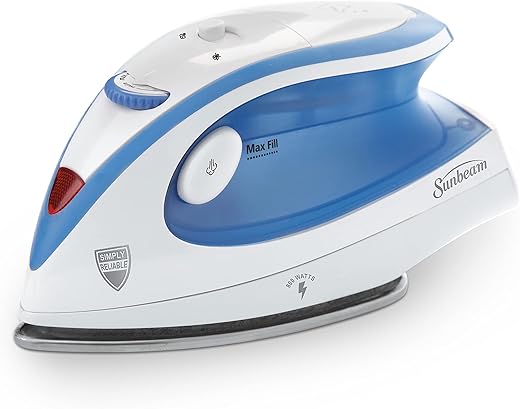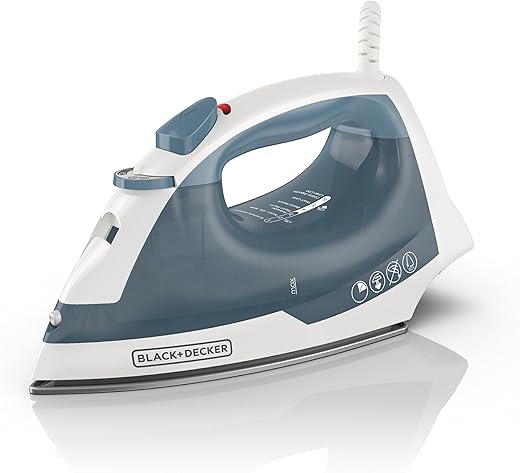
To maintain the performance of your portable travel iron, follow these steps:
- Clean the iron regularly by wiping the soleplate with a damp cloth. This will remove any residue or build-up that may affect its performance.
- Use distilled water in your iron to prevent mineral deposits from clogging the steam vents. This will help maintain a steady flow of steam for efficient ironing.
- Avoid using the iron on rough or abrasive surfaces, as this can damage the soleplate. Always iron on a smooth and clean surface to prolong the lifespan of your iron.
- Store the iron properly when not in use. Make sure it is completely cooled down before putting it away to avoid any potential accidents or damage.
- Check the power cord and any other parts for any signs of wear or damage. If you notice any issues, have them repaired or replaced by a professional to prevent any electrical hazards.
Top Picks for Wrinkle-Free Travels!
Rowenta Expert Advice: How to Properly Clean Your Steam Iron
Clean the Iron's Surface
To clean the iron’s surface, start by unplugging it and letting it cool down completely. Next, take a damp cloth and gently wipe the surface, making sure to remove any dust or residue. Remember to be cautious and avoid scratching the surface, especially if it has a non-stick coating.
Empty the Water Reservoir
To empty the water reservoir of your portable travel iron, follow these steps:
- Unplug the iron and allow it to cool down completely.
- Locate the water reservoir, usually located on the side or back of the iron, and remove the cap or lid.
- Hold the iron over a sink or basin and gently pour out any remaining water from the reservoir. Be careful not to spill any water on the iron’s surface.
- If there is any stubborn water left, you can shake the iron gently to help dislodge it.
- Once the water is emptied, replace the cap or lid securely.
- It’s also a good idea to wipe the exterior of the iron with a clean, dry cloth to remove any moisture.
By emptying the water reservoir after each use, you’ll prevent any mineral deposits from building up and clogging the iron’s steam vents. For example, if you forget to empty the reservoir and leave water in it, the next time you use the iron, you might notice that the steam output is reduced or the iron starts spitting out water instead of steam. So, be sure to make this a regular part of your iron maintenance routine to keep your portable travel iron working efficiently.
Descale the Iron
Regularly descale your portable travel iron to maintain its performance. Follow the manufacturer’s instructions to safely remove built-up mineral deposits. Start by unplugging the iron and allowing it to cool down. Then, fill the water tank with a descaling solution and let it sit for the recommended amount of time. Finally, rinse the tank thoroughly and run the iron on steam mode to flush out any remaining residue. Happy ironing!
Avoid Using Tap Water
To prevent mineral buildup and ensure optimal performance of your portable travel iron, use distilled or demineralized water instead of tap water. Tap water often contains minerals that can accumulate over time and affect the iron’s functionality. For example, minerals like calcium and magnesium can form deposits on the iron’s heating element, reducing its efficiency and causing uneven heat distribution. By using distilled or demineralized water, you can avoid these issues and prolong the lifespan of your iron.
Store Properly
- Store your portable travel iron in a clean and dry place when not in use.
- Neatly wrap and secure the cord to avoid damage.
- Examples: Wind the cord around the iron’s handle or use a cord organizer to keep it tidy.
- This will help prolong the lifespan of your iron and protect it from dust or accidental knocks.
Check the Power Cord
Regularly inspect the power cord for wear or damage. If you notice frayed wires or exposed parts, replace the cord immediately to prevent hazards.
Use the Right Temperature Settings
To ensure the best results when ironing your clothes, always refer to the care label on the garment and select the appropriate temperature setting on your portable travel iron. This will prevent any potential damage such as scorching or burning of the fabric, which can affect both the iron and your clothes. Paying attention to these details will help you achieve wrinkle-free garments without any mishaps.
Avoid Overfilling the Reservoir
- When filling the water reservoir of your portable travel iron, make sure to avoid overfilling it.
- Overfilling can lead to water leakage from the iron, which can cause damage or accidents.
- To prevent this, carefully monitor the water level and only fill the reservoir up to the recommended maximum capacity.
- By following this simple guideline, you can ensure the safe and efficient use of your portable travel iron.
Regularly Maintain and Service
To ensure long-term performance of your portable travel iron, periodically take it for servicing. A professional technician will be able to identify any underlying issues and perform necessary repairs, ensuring that your iron remains in excellent working condition. For example, if you notice that your iron is not heating up as quickly as before, it may be a sign that the heating element needs to be replaced. Taking your iron for servicing will help address such issues and extend the lifespan of your appliance.
Final Thoughts
In conclusion, taking proper care of your portable travel iron is essential for maintaining its performance and ensuring wrinkle-free clothes on the go. By following the steps outlined in this blog post, including cleaning, descaling, and using the right water, you can keep your iron in top shape. Remember to store it properly, check the power cord, and use the correct temperature settings to avoid any issues. Regular maintenance and avoiding overfilling will also contribute to its longevity. With these tips in mind, your portable travel iron will continue to be a reliable companion on all your travels.
Essential Equipment
Maximizing Iron Efficiency
Step-by-Step Guide to Using Your Portable Travel Iron
- Start by plugging in the portable travel iron to a power source and allow it to heat up. Most portable travel irons have temperature settings, so adjust it according to the fabric you will be ironing
- Ensure that the fabric you are ironing is clean and free from any stains or dirt. It’s always a good idea to wash and dry your clothes before ironing them
- Place the fabric on a flat and sturdy surface, such as an ironing board or a table covered with a clean cloth. Make sure the fabric is smooth and free of wrinkles
- Gently press the heated surface of the portable travel iron onto the fabric. Move the iron in a back and forth motion, applying slight pressure to remove any wrinkles or creases
- Be cautious when ironing delicate or sensitive fabrics, such as silk or lace. Adjust the temperature accordingly and use a pressing cloth or a piece of fabric to protect the delicate fabric from direct heat
- Once you have finished ironing a specific area, lift the iron and place it on a designated heat-resistant surface, such as an iron rest or a heatproof mat. This will prevent accidental burns or damage to other surfaces
- Finally, unplug the portable travel iron from the power source and allow it to cool down completely before storing it away. Always ensure the iron is completely cooled down to avoid any accidents or injuries
Frequently Asked Questions about Portable Travel Irons
Are there any safety features to consider when using a portable travel iron?
Yes, there are several safety features that you should consider when using a portable travel iron. Here are a few important ones:
- Auto Shut-off: Look for a travel iron with an auto shut-off feature. This means that if the iron is left unattended for a certain period of time, it will automatically turn off to prevent overheating and potential fire hazards.
- Temperature Control: Ensure that the travel iron has adjustable temperature settings. Different fabrics require different ironing temperatures, and having control over the heat will prevent damage to delicate materials.
- Non-Slip Grip: It’s important to choose a travel iron with a non-slip grip to prevent accidental slips or burns. This feature enhances your safety by providing a firm hold on the iron during use.
- Dual Voltage: If you plan to use the travel iron internationally, make sure it has dual voltage capability. This allows the iron to be used with different power systems around the world without the risk of damage or overheating.
- Heat-Resistant Bag or Pouch: Look for a travel iron that comes with a heat-resistant bag or pouch. This allows you to safely store the iron even when it’s still warm, reducing the risk of accidental burns or fires.















I followed all the steps in this guide, but I still notice some occasional dripping from the iron. Is there anything else I can do to fix this issue?
Sometimes, dripping can occur due to a faulty valve or seal. You may want to check if there are any visible signs of damage or if the iron needs to be serviced. If the issue persists, it’s best to contact the manufacturer or seek professional assistance for further troubleshooting.
I’ve tried using distilled water instead of tap water, and it really does make a difference. I used to have problems with mineral deposits clogging the steam vents, but since switching to distilled water, I haven’t had any issues. Highly recommend it!
Thank you for sharing your experience! Using distilled water is indeed a great way to prevent mineral buildup and maintain the performance of the iron. It’s good to hear that it has worked well for you.
One tip I have for maintaining the performance of a portable travel iron is to use a silicone iron rest. It helps protect the ironing board and prevents any stains or burns. Plus, it’s easy to fold and pack along with the iron. It’s been a game-changer for me!
That’s a great tip! Using a silicone iron rest is indeed a smart way to protect your ironing board and ensure safe ironing. Thank you for sharing this suggestion!
I found this guide very helpful. I followed all the steps and my portable travel iron is working like new again. I especially liked the tip about descaling the iron. I didn’t realize how important that was for maintaining its performance. Thanks for the great advice!
I have a slightly different way of storing my portable travel iron. Instead of just storing it in a drawer, I use a small travel case to keep it protected. This way, it doesn’t get bumped around or damaged during travel. It’s been working well for me so far.